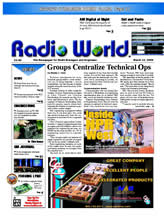
 |
|
|||||||||
|
|
 |
||||||||
 |
Mark's Two-Hour AM Micro-Proof by Mark Persons |
Radio World Article June 4, 2003 |
| AM radio is still very much alive and profitable
in Minnesota, especially in small towns. I love these places because they offer news, information and flavor for the local communities being served. It is in those towns that the owner/manager of the station will often corner me to say, "The AM is not reaching out as far as it used to ... and would you please check it out." In most cases, the station is non-directional, and no full or even partial RF proof-of-performance measurements were ever taken. None is required under FCC rules for non-directional operation. If there were previous measurements, I could go out and check field intensity at a few previously measured points to confirm or deny the manager's claim. Put GPS to work
Assuming no previous field intensity measurements
were ever taken, there are several approaches. I could order 15-minute topographical maps and
spend most of a week plotting radials, driving to points on those radials,
measuring the points and analyzing the signal levels. This may be a bit much for
a low-budget local station. I could use a road map and plot some radials
within two miles of the tower and measure wherever possible. However, this can
lead to errors when the map is not easily scaled. The measurements could be far
enough off to give misleading results. A third approach seems to take care of most of
the above problems. Use a Global Positioning System unit to get the
coordinates of the tower. This is important because the licensed location may
not be the actual location. Then drive around making measurements wherever it is
convenient and include a set of GPS coordinates with every reading. In this
case, I mean 20 or more measurements within two miles of the tower. This can be
done in less than two hours. I did this recently at a station and was amazed
at how quickly measurements could be made and logged. I was able to pick
locations with a minimum of potential power line interference and I did not need
to find specific locations to measure. As long as I took at least four measurements in
each of four directions, I could be reasonably assured that the antenna
efficiency could be estimated. Again, I was not driving in straight lines. I
took measurements wherever it felt good to do so. Quick check
Back in the office I ran calculations on distance
and bearing from the tower. Distance is the most critical as measurements change
quickly when they are made near the tower. That is why the GPS is so important. I compared those readings against expected
readings at each distance based on estimated ground conductivity. The readings
were mathematically averaged. It didn't take long to answer the question. In essence, we are measuring antenna efficiency.
Remember, the measurements out to two miles or so have little to do with ground
conductivity and mostly reflect how well the antenna system is working. This is
not data that you or I can submit to the FCC, but rather a quick check to see if
things are working. If you find the average expected signal strength
is low, it is time to spend the money by getting maps and doing a full analysis
of the signal. I should point out that all measurements are dependent on the
station running the correct amount of power in the first place. This means
tuning the transmitter, as per the manufacturer's instructions, for the rated
efficiency. The antenna current should then match what the license says. If it does not, more work is required to verify
the exact power before any field measurements are done. Thanks to Mark Mueller of Mueller Broadcast
Design for some advice on this one. His Web site is
www.muellerbroadcastdesign.com. |
Mark Persons, W0MH, is certified by the Society of Broadcast Engineers as a Professional Broadcast Engineer and has more than 30 years experience. His Web site is www.mwpersons.com From the Radio World May 8, 2002 issue http://www.rwonline.com http://www.rwonline.com/reference-room/special-report/01_rwf_persons.shtml
|
|
Questions? Email Mark Persons: teki@mwpersons.com |
|
.